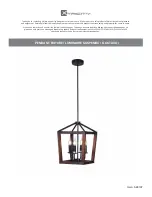
Condensing Economizers
Part No. 750-266
2-7
Deaerated water is recommended with any C-B economizer. Generally, schedule 80 steel pipe is used
in the piping installation. In some applications other piping material may be needed. Consider the type
of liquid, operating pressures and temperatures, and any corrosive elements in the liquid or in the
atmosphere when determining the best piping material for your installation. The use of unions and/or
flanges is recommended where isolation might be required. Stainless steel piping is recommended if
using non-deaerated water.
If a circulating pump is part of the system being installed, a ball or flow control valve installed on the
suction side of the pump and one on the discharge side of the pump will allow for easier pump removal
and replacement.
Drain piping should include valves of dependable manufacture in order to further reduce the possibility
of an undetected leak.
Safety relief valves (2 on C2X units) are provided as stan-
dard and should be piped separately and safely to the
drain.
NOTE:
The safety relief valves must be located between
any isolation valves and the economizer and within close
proximity of the exchanger. Liquid piping to and from the
exchanger should allow the exchanger to be filled at all
times especially when flow could stop.
The installation of a vent valve at the highest point in the
piping system is recommended in order to purge air out
especially during initial start up.
2.3.1- Special Installation Considerations
The C-B economizer may be installed inside or outside with appropriate drain piping installed for
shutdown periods. If there is a remote chance the temperatures outside might fall below freezing it is
recommended that care betaken to avoid potentially freezing the heat transfer core.
A drain connection and catch basin are provided in the bottom for all economizers and should be piped
to a floor drain using a water trap to prevent the escape of flue gases. Please note the submittal
drawing or consult C-B regarding location of the economizer drain.
Freeze protection concerns:
During a system shutdown where combustion halts for an extended period
of time (other than normal cycling), cold air will travel back down the stack and exhaust breechings,
through the exchanger and into the combustion source. If the cold air is below freezing, it could freeze
the finned tubing and cause a rupture, ultimately destroying the exchanger. For potential freezing
applications where the water flow might stop, a manual system shut down routine should be
incorporated. It is not recommended to use solenoid type drain valves for auto draining in sub zero
environments unless absolutely necessary.
Do not insulate the exchanger where factory insulation has already been applied or damage to the
exchanger can occur. Insulate piping and exhaust ducting as required.
Ensure that no liquid connections interfere with the opening of access door panels.
Figure 2.6 - C2X Safety Relief Valves
Summary of Contents for C1X Series
Page 1: ...Economizers 750 266 1 15 CRE CCE C2X C1X Operation Manual...
Page 2: ......
Page 6: ...vi NOTES...
Page 20: ...Standard Economizers 1 14 Part No 750 266 Figure 1 7 Piping with circulating tank BOILER...
Page 29: ...Condensing Economizers Part No 750 266 2 9 Figure 2 7 Dimension diagram C2X BB...
Page 33: ...Condensing Economizers Part No 750 266 2 13 Figure 2 9 Single boiler with deaerator...
Page 39: ...Condensing Economizers Part No 750 266 2 19 Figure 2 11 Two boilers with deaerator...
Page 51: ...Condensing Economizers Part No 750 266 2 31...
Page 52: ...e mail info cleaverbrooks com Web Address http www cleaverbrooks com...
















































